Sedum plants are easy to cultivate and have a vibrant color palette that may add a lot of interest to rock gardens and succulent collection! Because the plant comes in hundreds of variants, the most beautiful Types of Sedums that you can grow both indoors and outdoors.
Beautiful sedums, often known as stonecrops, conserve water in the garden. These drought-tolerant plants come in a variety of forms, colors, and sizes. These types have the greatest leaf colors, blooms, and shapes.
Sedum is one such plant genus in some popular species have been moved to different genera, despite the fact that they are still known as in the horticultural trade. The popular ‘Autumn Joy,’ is now technically recognized as Hylotelephium ‘Autumn Joy.’
Sedum plants come in a wide variety of colors, shapes, and sizes. Here are 11 of the most popular Sedum types to try in rock garden or container planter next!
Know more: How To Plant Sedum (Stonecrop Plant)
11 Sedum Varieties That Will Add Colors To Your Garden
The sedum plants types are very easy to grow and reproduce, and only way to harm them is to overwater or put them in excessively damp soil. A single branch or even a leaf placed into the ground will swiftly root and create a new plant in upright kinds.
Low-growing these plants spread quickly but are not invasive, and their shallow root systems make them easy to remove, making them great ground cover plants. This gorgeous succulent is an evergreen plant with thick and meaty leaves that is ideal for homes and gardens.
Here are the best Sedum varieties to plant.
1. Sedum album
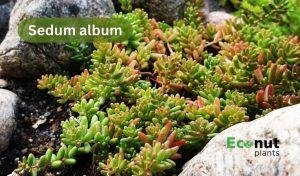
White flowers appear on Sedum album, which has green leaves that becomes crimson in the fall. It blooms in the summer and makes a great ground cover for rocky embankments or thin, weak soils. White sedum, on the other hand, is a slow-growing plant.
This Album is a species that blooms with white flowers from June through August. Drought conditions may cause the leaf to become pinkish, however this plant is drought tolerant.
Overview
- Native Area: Europe, Siberia, western Asia, North Africa
- USDA Growing Zone: 3–9
- Height: 3–5 inches
- Sun Exposure: Full; tolerates light shade
2. Angelina Sedum
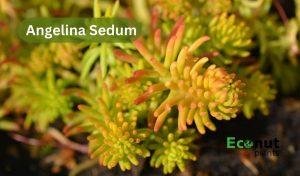
‘Angelina’ is a gold-leaved sedum that becomes bronze in the winter. Throughout the summer, little yellow flowers bloom. This mat-forming plant looks great in arid locations, rock gardens, pots, and hanging baskets, and its colour contrasts wonderfully with dark-leafed plants.
Angelina (Sedum rupestre ‘Angelina’) is a popular cultivar that blooms in June-August with yellow flowers. This low-growing succulent has eye-catching foliage that changes from golden-yellow to copper-orange in the winter.
Overview
- Native Area: Europe, Asia
- USDA Growing Zone: 3–9
- Height: 4–6 inches
- Sun Exposure: Full, Partial
3. Blue Spruce Sedum

The ‘Blue Spruce’ is called for the bluish needle-like foliage that resembles that of some evergreen shrubs, and it works well as a transition between low-sprawling evergreens like juniper or yews. This is a fast-growing shrub that blooms in mid- to late summer with a carpet of little yellow flowers.
Sedum reflexum ‘Blue Spruce’ (Sedum reflexum ‘Blue Spruce’) is a cultivar with yellow flowers that bloom in June-July. ‘Blue Spruce,’ with its silvery-blue foliage and needle-like leaves, is a striking sedum in boundary fronts or rock gardens. It blooms with yellow star-shaped flowers in the summer.
Overview
- Native Area: Europe
- USDA Growing Zone: 4–9
- Height: 4–8 inches
- Sun Exposure: Full
4. Murale Sedum
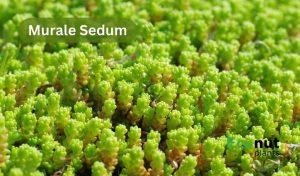
Sedum Murale (Sedum album subsp. teretifolium ‘Murale’) is a White Stonecrop cultivar that grows shorter than other white-flowering cultivars. The ‘Murale’ has bronze leaves and pink flowers that bloom in early summer and attract butterflies. It grows similarly to the rest of the species, but is a somewhat smaller plant overall.
This Murale thrives in full sun planting situations with well-draining soil. This variation grows to about 3′′ tall, making it an attractive blooming groundcover plant.
Overview
- Native Area: Europe, Siberia, western Asia, North Africa
- USDA Growing Zone: 3–9
- Height: 2–3 inches
- Sun Exposure: Full; will tolerate light shade
5. Purple Emperor Sedum
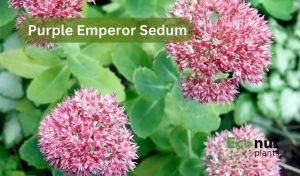
‘Purple Emperor,’ another species relocated out of the Sedum genus, has plum leaves and pink inflorescence that match plants with silver foliage or yellow flowers. This plant is more erect than many ground cover sedums. It’s perfect for filling gaps in rock gardens and sunny border gardens.
The Purple Emperor The purple-leaved (Sedum telephium ‘Purple Emperor’ or Hylotelephium telephium ‘Purple Emperor’) blooms from July to September. Purple Emperor thrives in full sun, but may tolerate mild shadow if sufficient indirect light is present.
Overview
- Native Area: Eurasia
- USDA Growing Zone: 4–9
- Height: 12–15 inches
- Sun Exposure: Full; enjoys some shade, especially in very hot climates
6. Hylotelephium Sieboldii

This plant was previously classified as a part of the Sedum genus, but it is now classified as a member of the related Hylotelphium genus. The Japanese stonecrop has silver-blue leaves with prominent red margins and hot-pink blossoms in the fall. The plant is particularly effective in brightening gloomy parts of a landscape.
Hylotelephium Sieboldii is a stonecrop that blooms in August-October with vivid pink flowers. October Daphne stonecrop has finely textured blue-green leaves that are bordered with a deep pink line. Because bees and butterflies adore its pink blossoms, this plant is ideal for pollinator gardens.
Overview
- Native Area: Japan
- USDA Growing Zone: 3–9
- Height: 3–4 inches
- Sun Exposure: Full; tolerates light shade, especially in hot climates
7. Cascade Stonecrop (Sedum Divergens)
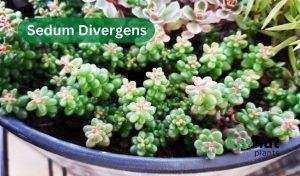
Sedum divergens, often known as cascading stonecrop or spreading stonecrop, is a perennial with yellow flowers that bloom in July. The leaves are green but have a crimson hue when exposed to direct sunlight. Individual plants can extend up to several feet from the crown in erratic directions.
Sedum Divergens is a kind of Sedum that blooms in June and July with vivid yellow flowers. This divergens may be cultivated in a variety of conditions, from full sun to moderate shade. This plant is especially tolerant to nutrient-deficient soils.
Overview
- Native Area: Western United States
- USDA Growing Zone: 4–9
- Height: 3–4 inches
- Sun Exposure: Full; tolerates light shade
8. Hylotelephium Ewersii
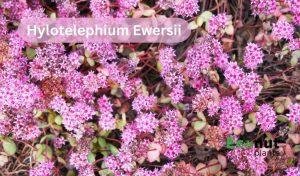
Sedum ewersii (and sometimes still sold under this name), pink Mongolian stonecrop is now officially known as Hylotelephium ewersii. This is a great tiny ground-cover plant with pink flowers that blooms in late summer. Blue-gray leaves. This Ewersii is a stonecrop that blooms in August and September.
Sedum Ewersii is adaptable and may be cultivated in a variety of conditions, from full sun to partial shade. This variety is drought-resistant and tolerant to nutrient-deficient soil. Pink Mongolian stonecrop is an excellent rock garden plant since it thrives in dry soil.
Overview
- Native Area: Himalayas
- USDA Growing Zone: 2–9
- Height: 4–6 inches
- Sun Exposure: Full, Partial
9. Ogon Sedum

Ogon Sedum (Sedum makinoi ‘Ogon’) is a Sedum cultivar with yellow-green leaves and blooms in August-September. This Ogon Sedum is a multi-purpose plant that may be cultivated in full sun to light shade. It’s a spreading groundcover with small, round-shaped golden leaves.
‘Ogon,’ known for its bright gold leaf, is a very eye-catching and easy-to-grow spreading groundcover. Tiny yellow-green blooms occur in the summer but are overshadowed by the leaves. It blooms with yellow-green, star-shaped flowers in the spring.
Overview
- Native Area: Japan
- USDA Growing Zone: 6–9
- Height: 2–5 inches
- Sun Exposure: Full, Partial
10. Russian Stonecrop (Sedum Kamtschaticum)

Russian stonecrop blooms with deep green foliage and brilliant yellow flowers. It’s a dependable, fast-growing plant that may be used to cover gaps in rock gardens or chinks in stone walls, as well as to blanket sunny regions. In the fall, the foliage turns a lovely copper colour.
Sedum Kamtschaticum is a species that blooms in June-August with yellow-orange flowers. Orange Stonecrop, Russian Stonecrop, and Kamchatka Stonecrop are all names for Sedum kamtschaticum. This is a cold-tolerant and sun-loving these species. It thrives on dry soil but needs rain to thrive.
Overview
- Native Area: Siberia
- USDA Growing Zone: 3–8
- Height: 3–6 inches
- Sun Exposure: Full
11. Coral Reef Sedum

Chinese sedum, often known as ‘Coral Reef,’ is one of the few sedum kinds with a warm yellowish tint. Tiny white or pink flowers bloom in July and August, but the leaves colour is the most noticeable feature. Coral Reef plant grows well in hot, sunny locations in the garden.
Because of its low, spreading character, ‘Coral Reef’ blends nicely with dark green plants and produces a great ground carpet when planted in bulk. It may even be grown in mild shade as long as there is sufficient of strong indirect light. It propagates easily from stem cuttings, as do most sedums.
Overview
- Native Area: Alpine regions of China
- USDA Growing Zone: 5–8
- Height: 2–3 inches
- Sun Exposure: Full
Also Read: Pothos Varieties: Know About Top 18 Types Of Pothos Plants
If you are searching fresh and live houseplants online then checkout our extensive collection of amazing indoor and outdoor houseplants.
I hope you enjoyed reading the sedum Varieties Guide. If you think we have forgotten something or have a suggestion, please leave it in the comment section below.

